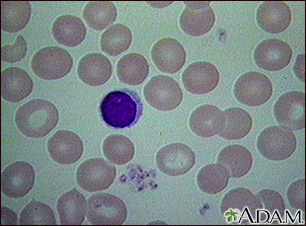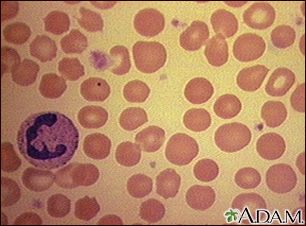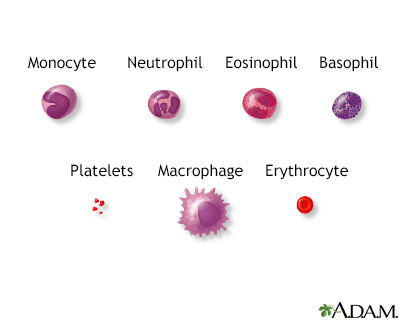Hereditary spherocytic anemia
Congenital spherocytic hemolytic anemia; Spherocytosis; Hemolytic anemia - spherocytic
Hereditary spherocytic anemia is a rare disorder of the surface layer (membrane) of red blood cells. It leads to red blood cells that are shaped like spheres, and premature breakdown of red blood cells (hemolytic anemia).
Images



Causes
This disorder is caused by a genetic variation. The variant gene results in an abnormal red blood cell membrane. The affected cells have a smaller surface area for their volume than normal red blood cells, and can break open easily.
The anemia can vary from mild to severe. In severe cases the disorder may be found in early childhood. In mild cases it may go unnoticed until adulthood.
This disorder is most common in people of northern European descent, but it has been found in all races.
Symptoms
Infants may have yellowing of the skin and eyes (jaundice) and pale coloring (pallor).
Other symptoms may include:
- Fatigue
- Irritability
- Shortness of breath
- Weakness
Exams and Tests
In most cases, the spleen is enlarged and can be detected by your health care provider.
Laboratory tests can help diagnose this condition. Tests may include:
- Blood smear to show abnormally shaped cells
- Bilirubin level
- Complete blood count (CBC) to check for anemia
- Coombs test
- Lactate dehydrogenase (LDH) level
- Haptoglobin level
- Osmotic fragility or specialized testing to evaluate for the red blood cell defect
- Reticulocyte count
Treatment
If the spleen is enlarged, surgery to remove it (splenectomy) cures the anemia but does not correct the abnormal cell shape.
Families with a history of spherocytosis should have their children screened for this disorder.
Children should wait until age 5 to have splenectomy because of the infection risk. In mild cases discovered in adults, it may not be necessary to remove the spleen.
Children and adults should be given a pneumococcal vaccine before spleen removal surgery. They also should receive folic acid supplements. Additional vaccines may be needed based on the person's history.
Support Groups
More information and support for people with hereditary spherocytic anemia and their families can be found at:
- Genetic and Rare Diseases Information Center -- rarediseases.info.nih.gov/diseases/6639/hereditary-spherocytosis
- National Organization for Rare Disorders -- rarediseases.org/rare-diseases/anemia-hereditary-spherocytic-hemolytic/
Outlook (Prognosis)
The outcome is usually good with treatment. After the spleen is removed, the life span of the red blood cell returns to normal.
Possible Complications
Complications may include:
- Gallstones
- Much lower red blood cell production (aplastic crisis) caused by a viral infection, which can make anemia worse
When to Contact a Medical Professional
Contact your provider if:
- Your symptoms get worse.
- Your symptoms do not improve with new treatment.
- You develop new symptoms.
Prevention
This is an inherited disorder and may not be preventable. Being aware of your risk, such as a family history of the disorder, may help you get diagnosed and treated early.
Related Information
Hemolytic anemiaAnemia
Gallstones
References
Gallagher PG. Red blood cell membrane disorders. In: Hoffman R, Benz EJ, Silberstein LE, et al, eds. Hematology: Basic Principles and Practice. 8th ed. Philadelphia, PA: Elsevier; 2023:chap 46.
Prozora S, Gallagher PG. Hereditary spherocytosis. In: Kliegman RM, St. Geme JW, Blum NJ, et al, eds. Nelson Textbook of Pediatrics. 22nd ed. Philadelphia, PA: Elsevier; 2025:chap 507.
BACK TO TOPReview Date: 3/31/2024
Reviewed By: Todd Gersten, MD, Hematology/Oncology, Florida Cancer Specialists & Research Institute, Wellington, FL. Review provided by VeriMed Healthcare Network. Also reviewed by David C. Dugdale, MD, Medical Director, Brenda Conaway, Editorial Director, and the A.D.A.M. Editorial team.

Health Content Provider
06/01/2025
|
A.D.A.M., Inc. is accredited by URAC, for Health Content Provider (www.urac.org). URAC's accreditation program is an independent audit to verify that A.D.A.M. follows rigorous standards of quality and accountability. A.D.A.M. is among the first to achieve this important distinction for online health information and services. Learn more about A.D.A.M.'s editorial policy, editorial process and privacy policy. A.D.A.M. is also a founding member of Hi-Ethics. This site complied with the HONcode standard for trustworthy health information from 1995 to 2022, after which HON (Health On the Net, a not-for-profit organization that promoted transparent and reliable health information online) was discontinued. |
The information provided herein should not be used during any medical emergency or for the diagnosis or treatment of any medical condition. A licensed medical professional should be consulted for diagnosis and treatment of any and all medical conditions. Links to other sites are provided for information only -- they do not constitute endorsements of those other sites. © 1997- 2025 A.D.A.M., a business unit of Ebix, Inc. Any duplication or distribution of the information contained herein is strictly prohibited.
